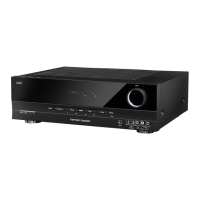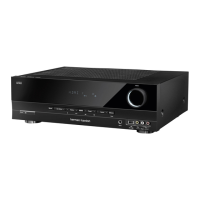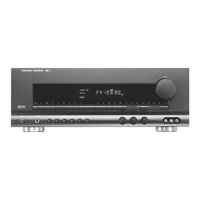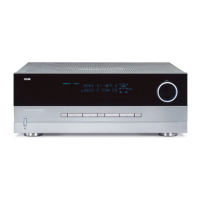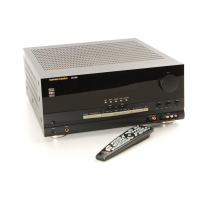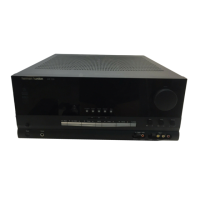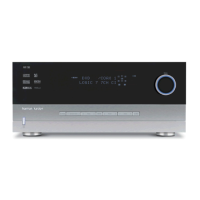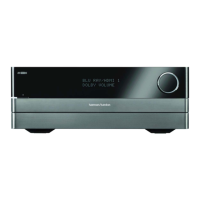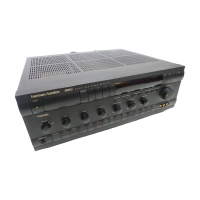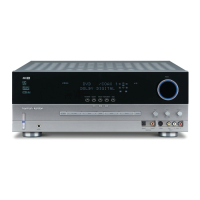18 INSTALLATION AND CONNECTIONS
System and Power Connections
The AVR 7000 is designed for flexible use with
multiroom systems, external control components
and power amplifiers.
Main Room Remote Control Extension
If the receiver is placed behind a solid or smoked
glass cabinet door, the obstruction may prevent
the remote sensor from receiving commands. In
this event, the remote sensor of any Harman
Kardon or other compatible device, not covered
by the door, or an optional remote sensor may
be used. Connect the Remote IR Output of
that device or the output of the remote sensor to
the Remote IR Input jack
c
.
If other components are also prevented from
receiving remote commands, only one sensor is
needed. Simply use this unit’s sensor or a remote
eye by running a connection from the Remote
IR Output jack
a
to the Remote IR Input
jack on Harman Kardon or other compatible
equipment.
NOTE: All remotely controlled components must
be linked together in a daisy chain. Connect the
IR OUT jack of one unit to the IR IN of the next
to establish this chain.
Multiroom IR Link
The key to remote room operation is to link the
remote room to the AVR 7000’s location with
wire for an infrared receiver and speakers or an
amplifier. The remote room IR receiver (this can be
an optional IR receiver or any other remotable
Harman Kardon device in the remote room with
IR sensor integrated) should be connected to the
AVR 7000 via standard coaxial cable. Connect the
Remote IR Output of the device or of the
optional sensor with the Multiroom IR Input
jack
b
on the AVR 7000’s rear panel.
If other Harman Kardon compatible source
equipment is part of the main room installation,
the Remote IR Output jack
a
on the rear
panel should be connected to the IR IN jack on
that source device. This will enable the remote
room location to control source equipment func-
tions in addition to the remote room input and
volume.
Multiroom Audio/Video Connections
Depending on the distance from the AVR 7000
to the remote room, two options (A and B) are
available for audio connection:
A. Use high-quality, shielded stereo audio inter-
connect cable with phono plugs on both ends
from the AVR 7000’s location to the remote
room. At the remote room, connect the intercon-
nect cable to a stereo power amplifier. The
amplifier will be connected to the room’s speak-
ers. No volume control is required, as the AVR
7000 and the remote IR link will provide that
function. At the AVR 7000, plug the audio inter-
connect cables into the Multi-Room Output
jacks
d
on the AVR 7000’s rear panel.
NOTE: The remote power amplifier must have sig-
nal sensing capability or be left on constantly to
assure automatic operation at the remote room.
B. Place the amplifier that will provide power to
the remote location speakers in the same room
as the AVR 7000, and connect the Multiroom
Output jacks
d
on the rear panel of the AVR
to the audio input of the remote room amplifier.
Use the appropriate speaker wire to connect the
optional power amplifier to the remote speakers.
High-quality wire of at least 2.5 mm
2
is recom-
mended for long multiroom connections.
The AVR 7000’s multiroom system is also capa-
ble of sending either S-Video or standard com-
posite video to the remote room location.
Connect the video feeds for the remote location
to the Multiroom Output
d
video jacks. Note
that standard S-Video cables may not provide
acceptable signal quality when used for runs
longer than 10 m. Consult your dealer or
installer for additional cable options for S-Video
applications. When running longer lengths of
composite video cable for multi-room applica-
tions, we recommend that dual shield or quad
shield RG-6 cable be used.
IMPORTANT NOTE: Any cables run inside walls
should carry any certification that is required by
the local building and electrical codes.To avoid
interference, audio and speaker cables should not
be parallel to, or run in the same conduits or path
with,AC cables. If you have any questions about
multiroom wiring, consult your dealer, custom
installer or low-voltage electrical contractor.
External Audio Power Amplifier
Connections
If desired, the AVR 7000 may be connected to
optional, external audio power amplifiers or
used with equalizers or speaker systems that
require connection between the preamp and
amplifier sections of a receiver.
To make these connections, remove the jumpers
that connect the Preamp Out jacks
fl
and
Amplifier In jacks
⁄
for the channels to be
used with external devices. Store the jumpers in
a safe place so that the AVR may be used in its
normal mode at a future date, if desired.
When an external amplifier is used, connect the
Preamp Out jacks
fl
to the inputs on the
amplifier. When an equalizer or speaker proces-
sor is used, connect the Preamp Out jacks
fl
to the inputs of the processor, and connect the
outputs of the processor back to the Amplifier
In jacks
⁄
on the AVR. Note that when external
amplifiers or devices are used, the volume con-
trol is still controlled by the AVR, although addi-
tional volume controls on the external device
may impact the volume settings and output lev-
els from the AVR.
Installation and Connections
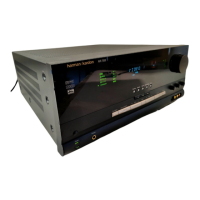
